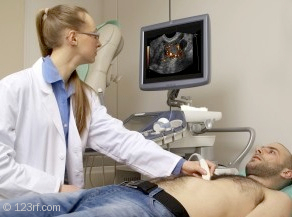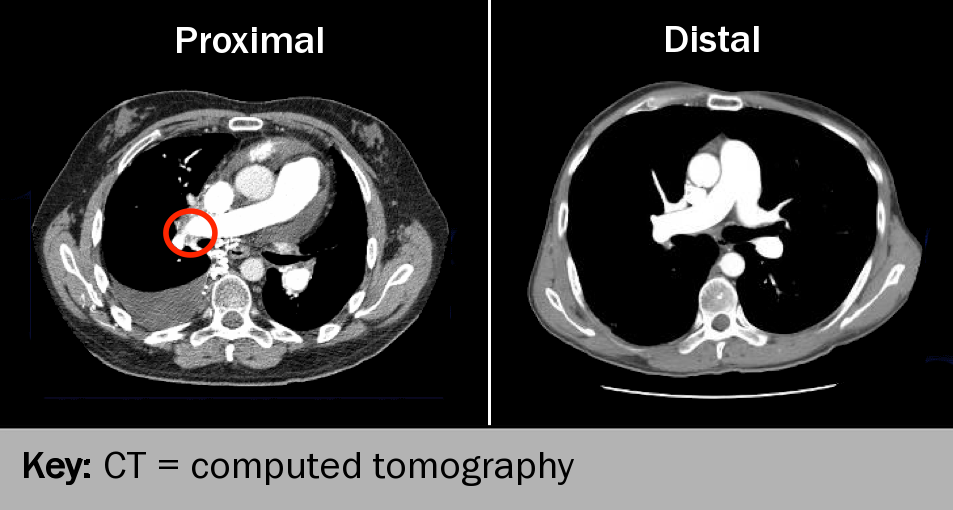The genetics of PAH
Fewer than 10% of PAH patients have a known family history of PAH.17 The true percentage may be higher since such family histories can go unrecognised. The major genetic predisposing factor is heterozygous loss of function mutations in bone morphogenetic protein receptor type 2 (BMPR2), which has been recognised in more than 70% of heritable PAH (HPAH) and a smaller number of idiopathic PAH (IPAH) cases. Some 300 BMPR2 mutations have been identified to date.18 Two further members of the transforming growth factor (TGF)-beta superfamily are also involved uncommonly: mutations in activin-like kinase (ALK1) and endoglin (ENG) cause hereditary haemorrhagic telangiectasia, which may be associated with the development of PAH. The genetic basis of associated forms of PAH is unclear.
The presence of a gene mutation does not necessarily mean that the individual will develop PAH during their life as the gene is thought to have only a 20% penetrance. As a consequence, PAH may jump generations. It is believed that a “second hit” in the form of an environmental trigger may be required to precipitate PAH in patients harbouring a mutation. Whilst it has been shown that there is an earlier age of diagnosis in successive generations of families with mutations, it is unclear as to whether this is due to true genetic anticipation or as a consequence of increased awareness of the disease in affected families and hence earlier presentation to medical professionals.
Genetic testing

Family-based risk assessment, including genetic counselling, should be undertaken by genetics services.19 Patients with a family history of PAH should be offered this service, which may include molecular genetic testing after comprehensive genetic counselling.19 At-risk relatives may wish to receive genetic counseling and clinical monitoring for early detection of disease. The frequency at which clinical monitoring should be undertaken is unclear.19
First-degree relatives of patients with iPAH should be provided with information about the genetic basis for this disorder, including recognition of the low recurrence and offspring risk.20
Learning point
- Genetic testing is available in PAH. This should not be undertaken without genetic counselling
Drug- and toxin-induced PAH
The appetite suppressants aminorex, fenfluramine and dexfenfluraramine, and additionally toxic rapeseed oil, are risk factors for the development of PAH, as demonstrated by epidemics or large epidemiological studies.21,22 Amphetamines, l-tryptophan and methamphetamine are likely risk factors for PAH. Possible risk factors include cocaine, phenylpropanolamine, St John’s Wort, chemotherapeutic agents and selective serotonin reuptake inhibitors (SSRIs). In pregnant women after 20 weeks of gestation, the SSRIs may play a role in development of persistent pulmonary hypertension of the newborn.23 It is unlikely that cigarette smoking, oral contraceptives and oestrogen are risk factors for PAH.
For further details, see the 2009 updated clinical classification of pulmonary hypertension.3
Learning point
- A number of risk factors for PAH have been identified, including appetite suppressants
Screening for pulmonary hypertension
 Monitoring for heritable PAH is discussed in the previous section. Breathless patients with a concurrent disease of which PAH is a known complication should be offered screening with echocardiography. Cardiac catheterization should be considered when the peak tricuspid regurgitation velocity is >2.8 m/s on echocardiography. There is no direct translation of the echocardiographic peak tricuspid regurgitation velocity to mean pulmonary arterial pressure in mm Hg. Clinical judgement about when to undertake cardiac catheterisation should be used and current guidelines followed. Connective tissue disease (CTD) annual screening should be offered to patients with limited cutaneous scleroderma or mixed CTD with U1 RNP antibodies using echocardiography and lung diffusing capacity (DLCO). Individuals with risk factors that predispose to PAH should undergo periodic screening. The approach is dictated by the risk factor–guideline recommendations.
Monitoring for heritable PAH is discussed in the previous section. Breathless patients with a concurrent disease of which PAH is a known complication should be offered screening with echocardiography. Cardiac catheterization should be considered when the peak tricuspid regurgitation velocity is >2.8 m/s on echocardiography. There is no direct translation of the echocardiographic peak tricuspid regurgitation velocity to mean pulmonary arterial pressure in mm Hg. Clinical judgement about when to undertake cardiac catheterisation should be used and current guidelines followed. Connective tissue disease (CTD) annual screening should be offered to patients with limited cutaneous scleroderma or mixed CTD with U1 RNP antibodies using echocardiography and lung diffusing capacity (DLCO). Individuals with risk factors that predispose to PAH should undergo periodic screening. The approach is dictated by the risk factor–guideline recommendations.
Associated pulmonary arterial hypertension (APAH)
PAH is seen in association with a number of other conditions, including connective tissue diseases, congenital heart disease and haemolytic anaemias. In some at-risk groups periodic screening is recommended, even in asymptomatic individuals; in others, investigation is suggested only when the patient develops symptoms (usually breathlessness).
Patients who have congenital heart disease with systemic-to-pulmonary shunts are at risk of developing PAH, as a consequence of exposure of the pulmonary vessels to increased blood flow and increased pressure. At the time of diagnosis, patients should be given an echocardiogram and right heart catheterisation as considered appropriate. Please note that catheterisation is not always essential in congenital heart disease. In addition, surgical repair may be considered for patients with a significant shunt.
PAH is a complication of CTD. It occurs most commonly in patients with scleroderma but also in SLE and rheumatoid arthritis. Annual echocardiography has been recommended for the first group of patients, but only when symptoms develop in the other groups.
PAH is seen in roughly 0.5% of patients with HIV, and may be an indirect effect of the virus on inflammation and growth factors. Routine screening of asymptomatic patients is not recommended but if patients develop shortness of breath then investigation should include echocardiography. Screening is not routine in patients with HIV infection or chronic haemolytic anaemia.
The risk of developing PAH increases with duration of portal hypertension, and may be as high as 4% in patients with advanced liver disease awaiting transplantation. If transplantation is under consideration then echocardiography should be performed, and cardiac catheterisation if evidence of PAH is demonstrated. (PAH is predictive of poor outcome after transplantation.) Screening is recommended as part of the workup for liver transplantation.
The development of PAH has been linked to exposure to anorexigens and structurally related compounds such as fenfluramine. Echocardiography is required only if the patient is symptomatic.
Pulmonary hypertension is increasingly recognised in association with haemoglobinopathies such as sickle cell disease and thalassaemia. These patients may be offered annual echocardiography, although this is a matter of debate at the present time.
Pulmonary embolism

Some 2–4% of patients who develop an acute pulmonary embolism (PE) go on to develop chronic thromboembolic pulmonary hypertension (CTEPH) (figure 6). Those most at risk have certain factors specific to PE (recurrent or idiopathic PE, large perfusion defects at diagnosis, young or old age at diagnosis, and echocardiographic evidence of PH at diagnosis or six months later), concurrent chronic medical conditions, associated thrombotic factors and genetic factors.24 Echocardiography may be offered to patients within six months after acute PE but the value of this remains to be proven.
Learning point
- Contrast CT may not detect distal thromboembolic disease
close window and return to take test
References
1 Galie N, Hoeper MM, Humbert M et al. The task force for the diagnosis and treatment of pulmonary hypertension of the European Society of Cardiology (ESC) and the European Respiratory Society (ERS), endorsed by the International Society of Heart and Lung Transplantation (ISHLT). Guidelines for the diagnosis and treatment of pulmonary hypertension. Eur Heart J 2009;30:2493–537. http://dx.doi.org/10.1093/eurheartj/ehp297
2 Gibbs, JSR, et al.. Consensus statement on the management of pulmonary hypertension in clinical practice in the UK and Ireland.Thorax 2008;63:ii1-35. http://dx.doi.org/10.1136/thx.2007.090480
3 Simonneau G, Robbins IM, Berghetti M et al. Updated clinical classification of pulmonary hypertension. J Am Coll Cardiol 2009;54: S43–S54. http://dx.doi.org/10.1016/j.jacc.2009.04.012
4 Tuder RM, Abman SH, Braun T et al. Development and pathology of pulmonary hypertension. J Am Coll Cardiol 2009;54:S3–S9. http://dx.doi.org/10.1016/j.jacc.2009.04.009
5 McLaughlin VV, Archer SL, Badesch DB, et al. ACCF/AHA 2009 Expert Consensus Document on Pulmonary Hypertension. J Am Coll Cardiol 2009;53:1573–619. http://dx.doi.org/10.1016/j.jacc.2009.01.004
6 Hassoun PM, Mouthon L, Barbera JA, et al. Inflammation, growth factors and pulmonary vascular remodeling. J Am Coll Cardiol 2009;54:S10–S19. http://dx.doi.org/10.1016/j.jacc.2009.04.006
7 Christman BW, McPherson CD, Newman JH, et al. An imbalance between the excretion of thromboxane and prostacyclin metabolites in pulmonary hypertension. N Engl J Med 1992;327: 70–5. http://dx.doi.org/10.1056/NEJM199207093270202
8 Rubens C, Ewert R, Halank M et al. Big endothelin-1 and endothelin-1 levels are correlated with the severity of primary pulmonary hypertension. Chest 2001;120:15662–9. http://dx.doi.org/10.1378/chest.120.5.1562
9 Bonnet S, Michelakis ED, Porter CJ, et al. An abnormal mitochondrial-hypoxia inducible factor-1alpha-Kv channel pathway disrupts oxygen sensing and triggers pulmonary arterial hypertension in fawn hooded rats: similarities to human pulmonary arterial hypertension. Circulation 2006;113:2630–41. http://dx.doi.org/10.1161/CIRCULATIONAHA.105.609008
10 Humbert M, Sitbon O, Chaouat A, et al. Pulmonary arterial hypertension in France: results from a national registry. Am J Respir Crit Care Med 2006;173:1023–30. http://dx.doi.org/10.1164/rccm.200510-1668OC
11 Badesch DB, Champion HC, Gomez Sanchez M, et al. Diagnosis and assessment of pulmonary arterial hypertension. J Am Coll Cardiol 2009;54:S55–S66. http://dx.doi.org/10.1016/j.jacc.2009.04.011
12 Mukerjee D, St George D, Coleiro B, et al. Prevalence and outcome in systemic sclerosis-associated pulmonary arterial hypertension: application of a registry approach. Ann Rheum Dis 2003;62;1088–93. http://dx.doi.org/10.1136/ard.62.11.1088
13 Tapson VF, Humbert M. Incidence and prevalence of CTEPH. Proc Am Thorac Soc 2006;3:564–7.
14 National audit of pulmonary hypertension 2011. NHS Information Centre 2011. Available from https://catalogue.ic.nhs.uk/publications/clinical/heart/nati-pulm-hype-audi-2011/nati-pulm-hype-audi-2011-rep.pdf
15 World symposium on primary pulmonary hypertension 1998, held in Evian, France in 1998, and co-sponsored by the World Health Organization. Available from http://web.archive.org/web/20020408173726/http://www.who.int/ncd/cvd/pph.html
16 Humbert M, Sitbon O, Chaouat A, et al. Survival in patients with idiopathic, familial, and anorexigen-associated pulmonary arterial hypertension in the modern management era. Circulation 2010;122:156–63. http://dx.doi.org/10.1161/CIRCULATIONAHA.109.911818
17 Rich S, Dantzker DR, Ayres SM, et al. Primary pulmonary hypertension: a national prospective study. Ann Intern Med 1987;107:216–23.
18 Machado RD, Eickelberg O, Elliott G, et al. Genetics and genomics of pulmonary arterial hypertension. J Am Coll Cardiol 2009;54 (Suppl S):S32–S42. http://dx.doi.org/10.1016/j.jacc.2009.04.015
19 Deng Z, Morse JH, Slager SL, et al. Familial primary pulmonary hypertension (gene PPH1) is caused by mutations in the bone morphogenetic protein receptor-II gene. Am J Hum Genet 2000;67:737–44.
20 Black CM. Foreword, Consensus statement on the management of pulmonary hypertension in clinical practice in the UK and Ireland. Thorax 2008;63(Suppl II): ii1–ii41. http://dx.doi.org/10.1136/thx.2007.090480
21 Fishman AP. Clinical classification of pulmonary hypertension. Clin Chest Med 2001;22:385–91.
22 Simonneau G, Galie N, Rubin LJ, et al. Clinical classification of pulmonary hypertension. J Am Coll Cardiol 2004;43:5S–12S.
23 Chambers CD, Hernandez-Diaz S, Van Marter LJ, et al. Selective serotonin-reuptake inhibitors and risk of persistent pulmonary hypertension of the newborn. N Engl J Med 2006;354:579–87. http://dx.doi.org/10.1056/NEJMoa052744
24 Piazza G, Goldhaber SZ. Chronic thromboembolic pulmonary hypertension. N Engl J Med 2011;364:351–60. http://dx.doi.org/10.1056/NEJMra0910203
Suggested further reading:
Lang IM, Benza R. Pulmonary hypertension: chapters of innovation and tribulation. Eur Heart J 2012;33:961-8. http://dx.doi.org/10.1093/eurheartj/ehs049
de Perrot M, Fadel E, McRae K, et al. Evaluation of persistent pulmonary hypertension after acute pulmonary embolism. Chest 2007;132:780–5. http://dx.doi.org/10.1378/chest.06-2493
Kiely DG, Elliot CA, Sabroe I, Condliffe R. Pulmonary hypertension: diagnosis and management. BMJ 2013;346:f2028. http://dx.doi.org/10.1136/bmj.f2028
close window and return to take test
All rights reserved. No part of this programme may be reproduced, stored in a retrieval system, or transmitted in any form or by any means, electronic, mechanical, photocopying, recording or otherwise, without the prior permission of the publishers, Medinews (Cardiology) Limited.
It shall not, by way of trade or otherwise, be lent, re-sold, hired or otherwise circulated without the publisher’s prior consent.
Medical knowledge is constantly changing. As new information becomes available, changes in treatment, procedures, equipment and the use of drugs becomes necessary. The editors/authors/contributors and the publishers have taken care to ensure that the information given in this text is accurate and up to date. Readers are strongly advised to confirm that the information, especially with regard to drug usage, complies with the latest legislation and standards of practice.
Healthcare professionals should consult up-to-date Prescribing Information and the full Summary of Product Characteristics available from the manufacturers before prescribing any product. Medinews (Cardiology) Limited cannot accept responsibility for any errors in prescribing which may occur.
